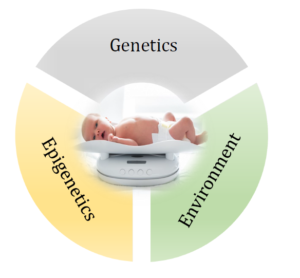
Obesity has become a global public health issue and an economic burden to both individuals and society. During the life-course it can further escalate this burden by manifesting other complex diseases such as diabetes and cardiovascular dysfunction.
Obesity can strike at any age, but there is growing evidence that pathways to obesity can begin as early as the first nine months of life in the womb. Early life is also a period of high plasticity and effective intervention; hence a comprehensive understanding of how different factors contribute to adiposity in this critical window of life can help minimize the obesity epidemic.
Origin of obesity is multifactorial

Obesity can be inherited; however genetic risk may not fully explain its origins. There are clearly other forms of variation that can trigger the onset of this disease. For the developing foetus, these variations can arise from exposure to a range of antenatal factors.
Maternal health adversities during pregnancy can create suboptimal in utero environment that can alter the biological pathways by affecting the epigenome. The altered epigenetic signatures in womb may persist at birth and continue to impact metabolic health in early childhood and later in the life-course.
While genetic risk constitutes fixed-effects, epigenetic and environmental variations are dynamic and modifiable. Besides their individual effects, genetic, epigenetic and environmental factors can influence each other’s role, or work in an additive way in disease predisposition. Most studies in the past have primarily looked at the role of these factors independently, but rarely attempted a combined analysis.
Focusing on early life to address the obesity epidemic in a comprehensive way
Birthweight is often used as a surrogate outcome for evaluating the overall quality of the in utero environment and metabolic health of offspring at birth. Hence, in this study we conducted a comprehensive analysis of different factors that can influence birthweight. As a measure of quality of the in utero environment, we studied 30 prenatal factors that can influence birth outcomes.
We identified 11 of these prenatal factors, including maternal adiposity, smoking, blood glucose and plasma unsaturated fatty acid levels to influence birth weight. The variation in birthweight was linked with DNA methylation changes at seven gene loci, with methylation levels at three of these birth weight linked loci being significantly associated with prenatal environment. Since this work was carried out in a birth cohort with prospective study design, we could also find the longitudinal association of these birthweight linked methylation sites with child adiposity.
As we know, in addition to environment and epigenome, genetic risk also plays an equally important role in disease predisposition. We tested if the polygenic risk scores associated with adult adiposity could explain variability in birth weight and child adiposity.
Our findings show an overlap between genetic influences on metabolic health in early and later life. We also investigated if the genetic risk score was associated with methylation levels at the seven gene loci mentioned above, and also if the genetic risk moderates the associations between methylation and birth weight/environment, but no significant associations were observed.
In summary, our findings show that developmental pathways to obesity are complex, as they can arise due to the combined effects of environmental, genetic and epigenetic factors. This also suggests that in order to be more effective, future studies aimed at diagnosis or interception of obesity in early life will have to be more mindful of the combined contributions of these factors.
This study was performed at Singapore Institute for Clinical Sciences (SICS), Agency for Science Technology and Research (A*STAR), in collaboration with National University Health System (NUHS) and KK Women’s and Children’s Hospital (KKH), and involved the GUSTO Birth Cohort.
One Comment